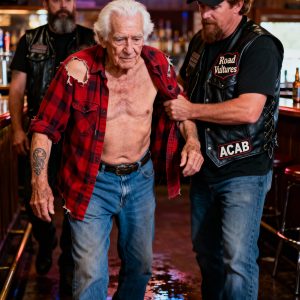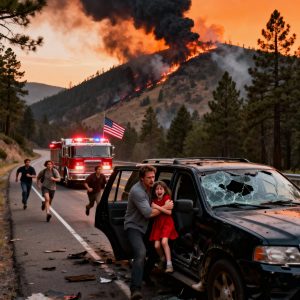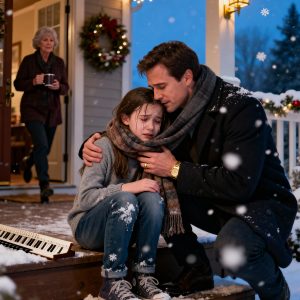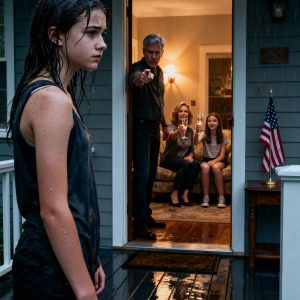The reunion hall smelled like old wood and memories. I stood near the punch bowl, scanning faces I hadn’t seen in decades, when she walked in. Claire. After all these years, my breath still caught the same way it did when I was seventeen.
We’d been kids together at Jefferson High. I’d spent months working up the courage to talk to her, and by the time I did, graduation scattered us in different directions. Life happened — I got married, had kids, and eventually said goodbye to my wife after her battle with cancer. Claire built a career helping others and never settled down. Or so I thought.
That night at the reunion, we talked for hours. It felt easy, natural, like coming home to a place you didn’t realize you’d been missing. Her laugh still had that gentle warmth that made everything feel lighter.
We started slow — phone calls that stretched into the evening, weekend visits to my place in Vermont, long drives with no real destination. One evening by the lake, with the sun painting the sky pink and orange, I asked her to be my wife. She said yes with tears streaming down her face.
Our wedding was simple and beautiful. Just the people who mattered most, witnessing two people who’d found each other again after a lifetime apart. Everyone kept saying how romantic it was, how it gave them hope that it’s never too late for love.
But that night, after the guests left and the house fell quiet, I found Claire sitting on the edge of our bed, shaking. She was holding a photograph — a young boy with bright green eyes and a baseball cap.
“I need to tell you something,” she said, her voice barely above a whisper. “His name was Michael. He was my son.”
My heart stopped. In all our months together, she’d never mentioned having a child.
She told me everything then. How she’d gotten pregnant at twenty-one, how the father left before she could even tell him. How she worked herself to exhaustion to give her son a good life. And how, when he was fifteen, a drunk driver took him from her on a rainy night after baseball practice.
I sat beside her and held her while she cried. All those years, she’d carried this alone.
The next morning felt strange. Claire was up early, making coffee like nothing had happened. But I could see it in her eyes — the weight of years spent keeping this part of herself locked away.
“Tell me about him,” I said over breakfast.
Her face changed. For the first time since our wedding, she smiled — really smiled. She told me about Michael’s curiosity, how he’d take apart anything with batteries just to understand how it worked. How he made her birthday cards with crooked letters that said “You’re my home.” She described the night of the accident in painful detail — the knock on the door, the hospital hallway that smelled like disinfectant, the jacket they handed her that still smelled like rain.
I didn’t try to fix anything. I just listened.
The weeks that followed taught me that grief doesn’t disappear. It lives in the quiet moments — when Claire would stop mid-sentence while cooking, or sit on the porch staring at something only she could see. I learned not to interrupt those moments. I just sat beside her.
Eventually, I suggested we visit his grave together. She’d been going alone for twenty-seven years.
The cemetery was peaceful. His stone sat beneath an old maple tree. Claire placed a white rose on the ground and whispered, “I’m sorry it took so long to bring someone here.”
Later, she told me she’d never let anyone truly know her after Michael died. She’d poured everything into her work, helping other people’s children, because it was easier than facing her own loss. “You’re the first person who made me feel like I could share this,” she said. “Like it was safe.”
That’s when I understood what love means at our age. It’s not about grand gestures or fresh starts. It’s about witnessing someone’s pain without trying to fix it. It’s about saying “you’re not alone” and proving it every single day.
We built new routines together. Sunday pancakes. Evening walks by the lake. We shared stories of the people we’d lost — I told her about my late wife, how I still reached for her side of the bed years after she was gone. Claire understood. She’d lived it too.
One day, Claire found a box in her attic. Inside was Michael’s baseball glove, some notebooks, and a cassette tape marked “For Mom.” Her hands shook as she pressed play. His voice filled the room: “Hey Mom, I love you. You’re the best. Don’t ever forget that.”
We both cried. For the children we’d lost, the years we’d carried pain alone, the different shapes love takes when life breaks your heart.
Something shifted in Claire after that. She started volunteering at a youth shelter for kids who’d lost parents. I watched her transform grief into purpose, pain into compassion. She wasn’t broken by what she’d been through — she was shaped by it in ways that made her even more remarkable.
We never pretended the grief was gone. Some nights she still woke up crying, calling Michael’s name. But we faced those nights together. I’d bring her water, hold her hand, remind her that he’d be proud of the person she’d become. And she’d smile through her tears.
On our first anniversary, we went back to the lake. The leaves had turned golden, the air crisp and clean. Claire leaned against me and said, “I used to think love ended when you lost someone. Now I think it just changes into something else.”
I kissed her forehead. “Then let’s keep finding new ways to love.”
At sixty-two, I thought my life was settling into its final chapter. But Claire showed me that beginning again is always possible, no matter how much loss you’ve survived. The heart doesn’t age like the body does. It just learns, grows, becomes capable of holding more.
Standing by that water, her hand in mine, I realized something important: Love doesn’t erase pain. It doesn’t make the grief disappear. It just gives it a safe place to exist.
Final Reflection:
Real love isn’t about perfection or fairy tale endings. It’s about showing up for someone, especially when they’re carrying burdens you can’t see. It’s about creating space for their whole story — the beautiful parts and the broken ones — and saying, “I’m here, and that’s enough.”
Disclaimer:
This article shares a personal story inspired by real-life experiences.





